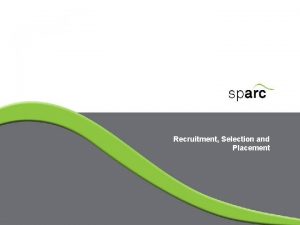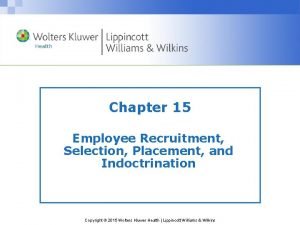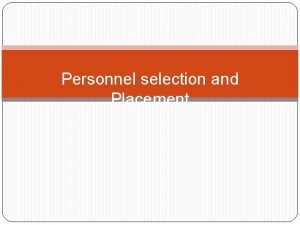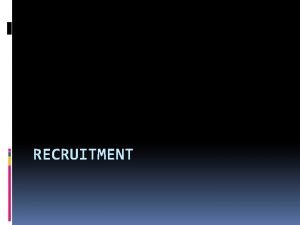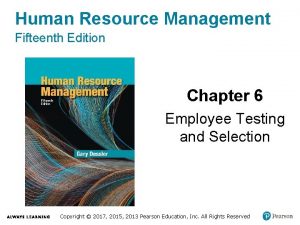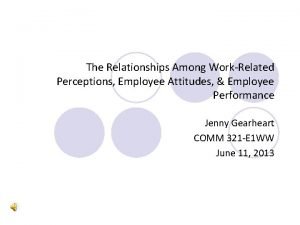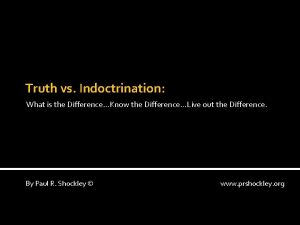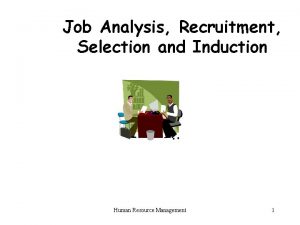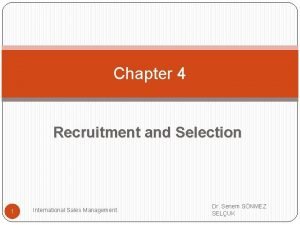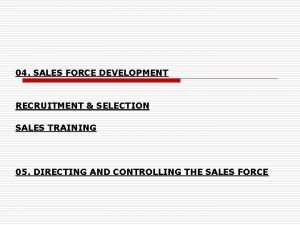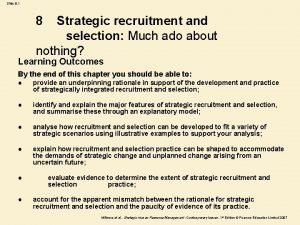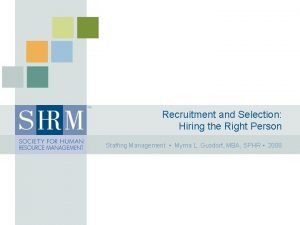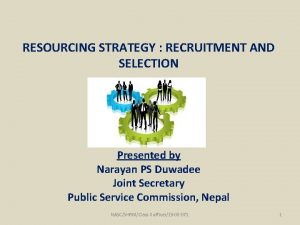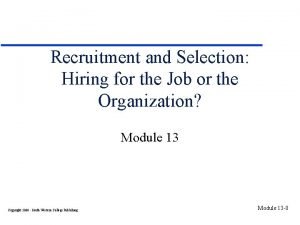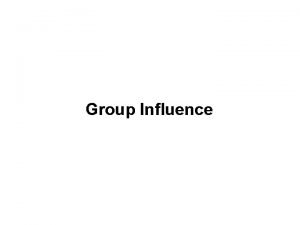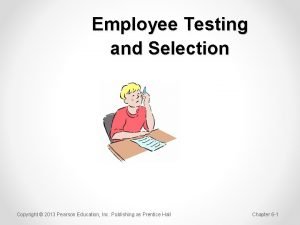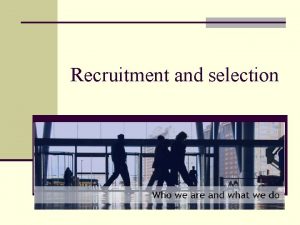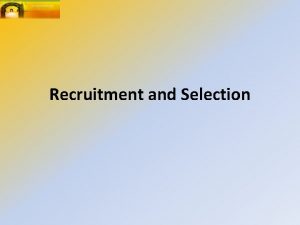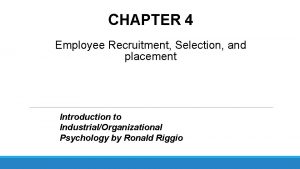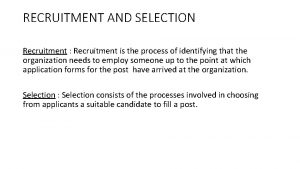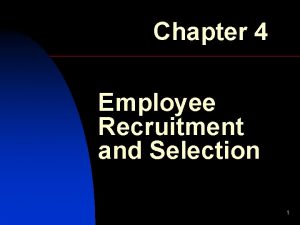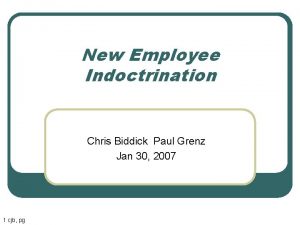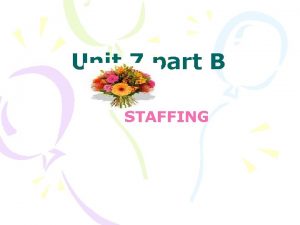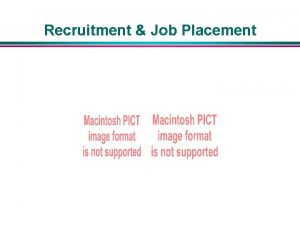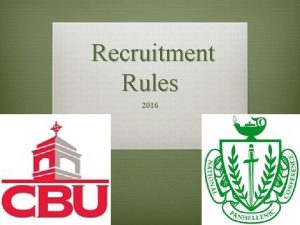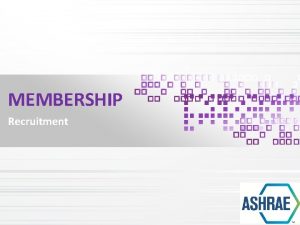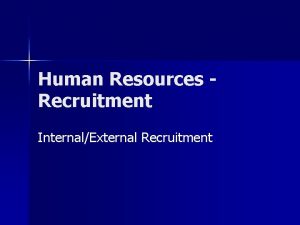Chapter 15 Employee Recruitment Selection Placement and Indoctrination


































- Slides: 34

Chapter 15 Employee Recruitment, Selection, Placement, and Indoctrination Copyright © 2015 Wolters Kluwer Health | Lippincott Williams & Wilkins

Staffing—The Third Phase of the Management Process • In staffing, the leader-manager recruits, selects, orients, and promotes personnel development to accomplish the goals of the organization • Staffing is an especially important phase of the management process in health-care organizations because such organizations are usually labor intensive (i. e. , many employees are required to accomplish organizational goals) Copyright © 2015 Wolters Kluwer Health | Lippincott Williams & Wilkins

Sequential Steps in Staffing • 1. Determine the number and types of personnel needed to fulfill the philosophy, meet fiscal planning responsibilities, and carry out the chosen patient care delivery system selected by the organization • 2. Recruit, interview, select, and assign personnel based on established job description performance standards • 3. Use organizational resources for induction and orientation • 4. Ascertain that each employee is adequately socialized to organization values and unit norms • 5. Use creative and flexible scheduling based on patient care needs to increase productivity and retention Copyright © 2015 Wolters Kluwer Health | Lippincott Williams & Wilkins

Factors Affecting Staffing Needs • Source of nursing pools • Number of students enrolled in local nursing schools • Usual length of employment of newly hired staff • Peak staff resignation periods • Times when patient census is highest • Patient care delivery system in place • Knowledge level of needed staff • Budget constraints Copyright © 2015 Wolters Kluwer Health | Lippincott Williams & Wilkins

Reminder • Historically, when the economy improves, nursing shortages occur. When the economy declines, nursing vacancy rates decline as well Copyright © 2015 Wolters Kluwer Health | Lippincott Williams & Wilkins

Seeking Employee Diversity • Having a staff that is diverse in terms of gender, culture, age, ethnicity, and language is helpful in meeting the needs of an increasingly diverse client population • Diversity also brings new perspectives to thinking and problem solving • Managers should be alert to the gender, culture, ethnicity, age, and language diversity in the communities served by their organization and should seek to recruit a staff that is both sensitive and responsive to that diversity Copyright © 2015 Wolters Kluwer Health | Lippincott Williams & Wilkins

Question What are some important aspects of diversity to consider in choosing a staff? A. B. C. D. E. Gender Culture Age Language All of the above Copyright © 2015 Wolters Kluwer Health | Lippincott Williams & Wilkins

Answer: Rationale: Copyright © 2015 Wolters Kluwer Health | Lippincott Williams & Wilkins

Staffing Shortages and the Economy • Nationwide downsizing of hospitals in the 1990 s • Aging of the nursing workforce • Accelerating demand for professional nurses • Inadequate enrollment in nursing programs of study • Aging of nursing faculty Copyright © 2015 Wolters Kluwer Health | Lippincott Williams & Wilkins

Factors Affecting Recruitment • Financial resources • Adequate nursing pool • Competitive salaries • The organization’s reputation • The location’s desirability • The status of the national and local economy Copyright © 2015 Wolters Kluwer Health | Lippincott Williams & Wilkins

Recruitment • The process of actively seeking out or attracting applicants for existing positions • Should be an ongoing process Copyright © 2015 Wolters Kluwer Health | Lippincott Williams & Wilkins

Recruitment Methods • Advertisements • Career days • Literature • Informal use of members of the organization as examples of satisfied employees Copyright © 2015 Wolters Kluwer Health | Lippincott Williams & Wilkins

Recruitment and Retention • One of the best ways to maintain an adequate employee pool is by word of mouth—the recommendation of the organization’s own satisfied and happy staff • Recruitment, however, is not the key to adequate staffing in the long term. Retention is, and it occurs only when the organization is able to create a work environment that makes staff want to stay Copyright © 2015 Wolters Kluwer Health | Lippincott Williams & Wilkins

Turnover • Some turnover is normal and in fact desirable • It infuses the organization with fresh ideas and reduces the probability of groupthink • However, excessive or unnecessary turnover reduces the ability of the organization to produce its endproduct and is expensive Copyright © 2015 Wolters Kluwer Health | Lippincott Williams & Wilkins

Interviewing as a Selection Tool • It is the most common method for employee selection used by managers • It is also the most time-consuming and thus one of the most costly selection tools • It generally requires an interviewer to use judgments, biases, and values to make decisions based on a short interaction with an applicant in an unnatural situation. Thus, reliability and validity are always suspect Copyright © 2015 Wolters Kluwer Health | Lippincott Williams & Wilkins

Purposes of the Selection Interview • The interviewer seeks to obtain enough information to determine the applicant’s suitability for the available position • The applicant seeks to obtain adequate information to make an intelligent decision about accepting the job, should it be offered • The interviewer seeks to conduct the interview in such a manner that, regardless of the interview’s result, the applicant will continue to have respect for and good will toward the organization Copyright © 2015 Wolters Kluwer Health | Lippincott Williams & Wilkins

Reliability and Validity Issues of the Selection Process • Validity increases with a team approach • Negative information tends to be weighed more heavily than positive information • The same standards should be used for all applicants • Selection should be based on established criteria, not value judgments • Personal bias should be minimized, because negative feelings likely have no relation to the criteria necessary for success in the position Copyright © 2015 Wolters Kluwer Health | Lippincott Williams & Wilkins

Limitations of the Interview Process as a Selection Tool 1. Subjectivity can never be totally eliminated 2. High interview assessments do not necessarily correlate with high-level performance on the job 3. Mixed reliability and validity: § Intra-rater reliability high § Inter-rater reliability low in unstructured interviews § Inter-rater reliability is better if interview is structured and same interview format is used by all interviewers Copyright © 2015 Wolters Kluwer Health | Lippincott Williams & Wilkins

Limitations of the Interview Process as a Selection Tool—(cont. ) • Negative information about the applicant is weighed more heavily than positive information, and the earlier in the interview, the greater the negative effect • Most decisions about the applicant are made in the first 30 to 60 seconds • In unstructured interviews, the interviewer generally does 80% to 90% of the talking. In structured interviews, the interviewer does only 50% to 60% of the talking • The environment is artificial and it is difficult for many interviewees to relax and be natural Copyright © 2015 Wolters Kluwer Health | Lippincott Williams & Wilkins

Limitations of the Interview Process as a Selection Tool—(cont. ) • The interviewer may have poor communication skills and be unable to generate a discussion • Physical appearance often contributes substantially to an interviewer’s opinion about an applicant • Interviewers frequently ask questions that demonstrate a self-fulfilling prophecy regarding their first impression of the applicant Copyright © 2015 Wolters Kluwer Health | Lippincott Williams & Wilkins

Subjectivity of Interview The major defect of the interview is subjectivity Copyright © 2015 Wolters Kluwer Health | Lippincott Williams & Wilkins

Question Tell whether the following statement is True or False: Positive information is usually weighed more heavily than negative information in an interview. A. True B. False Copyright © 2015 Wolters Kluwer Health | Lippincott Williams & Wilkins

Answer: Rationale: Copyright © 2015 Wolters Kluwer Health | Lippincott Williams & Wilkins

Overcoming Interview Limitations • Use a team approach • Develop a structured interview format for each job classification • Use scenarios to determine decision-making ability • Conduct multiple interviews • Provide training in effective interviewing techniques Copyright © 2015 Wolters Kluwer Health | Lippincott Williams & Wilkins

Suggested Interview Format • Introduce yourself and greet the applicant • Make a brief statement about the organization and position and clarify the position for which the person is applying • Discuss the information on the application and seek clarification or amplification as necessary • Discuss employee qualifications and proceed with structured interview format • If applicant is qualified, discuss the position further • Explain hiring procedures/terminate the interview Copyright © 2015 Wolters Kluwer Health | Lippincott Williams & Wilkins

Two Aspects Carrying Most Weight When Recommending for or Against Hiring • The requirements of the job – Qualified versus overqualified • Personal bias – Examine any negative feelings occurring in the interview for personal bias Copyright © 2015 Wolters Kluwer Health | Lippincott Williams & Wilkins

Common Job Interview Mistakes of Applicants • Arriving so early you appear overanxious • Saying too much • Wearing a coat/hat during the interview • Wearing psychologically intimidating colors or patterns • Sitting down before the interviewer does or addressing the interviewer by his or her first name • Asking about salary, vacation, or promotions too early in the interview Copyright © 2015 Wolters Kluwer Health | Lippincott Williams & Wilkins

Common Job Interview Mistakes of Applicants—(cont. ) • Bad-mouthing or revealing confidential information about a former or current employer • Not having any questions • Overstating your accomplishments • Having a “what can you do for me? ” attitude • Being vague, rambling, or evasive, all of which show poor communication skills • Lacking clear direction regarding what you want in your career • Showing apathy or lack of motivation Copyright © 2015 Wolters Kluwer Health | Lippincott Williams & Wilkins

Tips for the Applicant • Do your homework about the organization you are applying to • Practice the interview and rehearse answers to foreseeable questions about your education and experience • Be prompt on the day of the interview • Look your best for the interview. Dress conservatively and make sure you are neatly groomed Copyright © 2015 Wolters Kluwer Health | Lippincott Williams & Wilkins

Tips for the Applicant During the Interview The goal is to make a good first impression! • Be on time • Smile, shake hands, and maintain eye contact • Stand until the interviewer invites you to sit • Place personal belongings beside you on the floor • Do not slouch or fidget • Do not chew gum or smoke cigarettes • Bring a paper and pencil to make notes • Answer the questions with confidence and watch the interviewer for nonverbal cues Copyright © 2015 Wolters Kluwer Health | Lippincott Williams & Wilkins

Practice Interview Questions • Why do you want this job? • What is your philosophy of nursing? • What strengths and weaknesses do you bring to this job? • Why should we hire you? Why us? • What is your 20 -year career plan? • Can you define professionalism in nursing practice? • What do you know about our organization? Copyright © 2015 Wolters Kluwer Health | Lippincott Williams & Wilkins

Illegal Interview Inquiries • Age • Marital status • Children • Race • Sexual preference • Financial or credit status • National origin • Religion Copyright © 2015 Wolters Kluwer Health | Lippincott Williams & Wilkins

After the Interview 1. Send a thank-you note to the interviewer 2. If offered the job, send a formal letter accepting or rejecting the job 3. Personally critique the interview experience. Review in your mind what you did well and what you would do differently the next time Copyright © 2015 Wolters Kluwer Health | Lippincott Williams & Wilkins

Phases of Employee Indoctrination • Induction: includes all activities that educate the new employee about the organization and employment and personnel policies and procedures • Orientation: teaches activities that are more specific to the position • Individual orientation to each department: specific departments are responsible for developing their own orientation program Copyright © 2015 Wolters Kluwer Health | Lippincott Williams & Wilkins
 Recruitment and selection course outline
Recruitment and selection course outline Recruitment selection and placement
Recruitment selection and placement Personnel selection meaning
Personnel selection meaning External sources of recruitment images
External sources of recruitment images Chapter 6 employee testing and selection ppt
Chapter 6 employee testing and selection ppt Regulation of recruitment and placement activities
Regulation of recruitment and placement activities Recruitment and induction process
Recruitment and induction process Employee attitudes and employee performance
Employee attitudes and employee performance Difference between education and indoctrination
Difference between education and indoctrination Indoctrination vs education
Indoctrination vs education What is indoctrination
What is indoctrination Selection process in staffing
Selection process in staffing Define recruitment and selection
Define recruitment and selection Difference between hiring and recruitment
Difference between hiring and recruitment Introduction to recruitment and selection
Introduction to recruitment and selection Job analysis recruitment and selection
Job analysis recruitment and selection Hrm exam questions
Hrm exam questions Recruitment and selection of sales personnel
Recruitment and selection of sales personnel Recruitment of sales force
Recruitment of sales force Strategic selection process
Strategic selection process Selection in staffing
Selection in staffing Definition of recruitment and selection
Definition of recruitment and selection New trends in recruitment and selection
New trends in recruitment and selection Recruitment and selection in human resource management
Recruitment and selection in human resource management Recruitment and selection definition
Recruitment and selection definition Recruiting yield pyramid
Recruiting yield pyramid Objectives of resourcing strategy
Objectives of resourcing strategy Difference between hiring and recruitment
Difference between hiring and recruitment Selection and placement
Selection and placement External sources of recruitment
External sources of recruitment Elks indoctrination
Elks indoctrination Cult indoctrination
Cult indoctrination Employee testing and selection
Employee testing and selection Employee testing and selection summary
Employee testing and selection summary Employee testing and selection
Employee testing and selection
